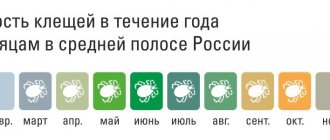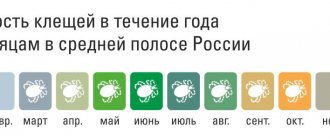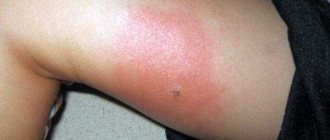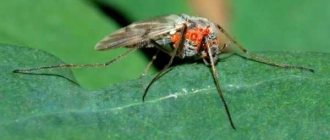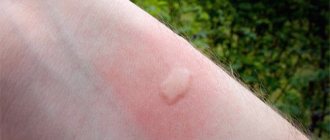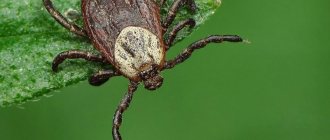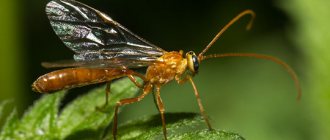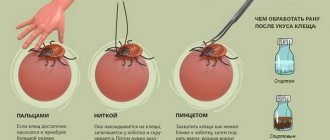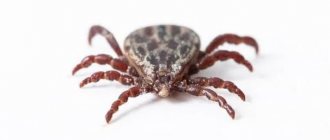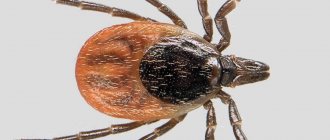How dangerous is the red tick?
Most people associate the word “tick” with something dangerous, unpleasant, and harmful. What if it's a red tick? How dangerous is it for humans and where does it come from?
Ticks are arachnid, blood-sucking parasites of very small size. Their habitat is very diverse and they usually live in soil and grass.
Red mite
Any type of tick can cause harm to the environment, food, animals or humans.
There are many types of ticks, and those that are carriers of serious diseases in humans and animals are especially dangerous. Once on the skin of a person or animal, the tick bites and drinks blood until it is satisfied or is removed. In this case, a person or animal may not feel anything. It is important to understand that serious infections can be transmitted through blood. This is precisely why ticks are dangerous.
Some types of mites are common plant pests. Such mites feed on cellular plant sap, thereby disrupting the necessary processes in the cells and depleting nutrient reserves. As a result, plant cells lose the ability to form the necessary substances for plant life. As a result, the plant may die. The red spider mite belongs to just such pests.
Harm and consequences
Regarding the harm that the parasite causes to the plant, the following stages can be noted. On the first, it is not so dangerous, since feeding on the juice of several individuals does not cause much damage; if you start fighting it in time, the flower will not be harmed. Inaction will soon lead to an imbalance in the water balance, since the plant lacks juice. At subsequent stages, the level of chlorophyll is significantly reduced and the process of photosynthesis stops.
The red mite can cause great harm to crops in the garden. In addition to the fact that you can lose most of the harvest, the crops simply die. Trees are also not spared parasites; in this case, they are dangerous because they cause harm at every stage of development.
What is a red spider mite?
One of the dangerous parasites of vegetation is the red spider mite.
Red spider mites cause damage to almost all types of plants - both garden and house flowers, as well as agricultural crops grown in greenhouses and outdoors. They spread wherever there is vegetation.
This is a very small tick that is practically invisible. It is always detected late - after the plant is affected by it. Most often, people find a parasite when signs of its existence are already visible on plants.
Red spider mite
The color of a spider mite is variable and depends on many factors. In most cases they are greenish, yellowish or red, or completely colorless. First of all, their color depends on what plant the mites live on and what they feed on.
You can suspect the appearance of a spider mite based on the following phenomena:
- yellowing of part of the leaf, and later of the entire leaf of the plant;
- drying out, falling off of flowers or leaves of a plant;
- the appearance of small dots on the leaves;
- unjustified stop in the development and growth of the plant;
- the presence of subtle cobweb threads.
The spider mite first settles on the inside of the leaves, then colonizes their upper part, and then all the green shoots. As a result, small white dots appear on the leaves and a cobweb appears, which entangles the plant or part of it. Small dots on the leaves are bite marks from plant tissue pests. If a plant is repeatedly eaten by a mite, the leaves begin to turn white because the pests have sucked out the juices and deprived the plant of chlorophyll, an essential green plant pigment. Then, if the necessary measures are not taken in time, the leaves will wither, dry out and fall off. The plant is completely covered with cobwebs and a lot of pests accumulate on the remaining leaves.
Signs of plant damage by spider mites
Mite reproduction depends on the temperature and humidity in the room. Dryness and warmth favor the rapid proliferation of spider mites; accordingly, plants that require such conditions and maintenance are more likely to suffer. This pest reproduces quite quickly: from the moment of laying eggs to the development of adult individuals, it takes only 2 weeks. Spider mites are also dangerous because they are capable of going into diapause, especially in unfavorable conditions for them, burrowing deep into the soil where they look for secluded places. As soon as conditions suitable for them are created again, the mites emerge from this state and begin to rapidly develop and multiply.
Spider mites are able to move quite quickly and far from a damaged plant to neighboring healthy ones. It is necessary to notice damaged plants in time and take appropriate measures.
Signs of defeat
The red mite is located on the inside of the leaves. Since this insect is very small, it can only be seen with a magnifying glass. The tick bite itself is not visible, only its consequences are visible. In appearance, the lesion of the flat beetle is practically no different from the traces of other pests. A clear sign of the presence of an insect is the presence of small brown dots. In case of severe infection, the leaf is practically covered with many dots and spots. The flat beetle bites the plant and sucks the juice out of it, as a result of which it loses its vitality, and the leaves begin to turn yellow and fall off.
Small punctures are not so scary as the consequences they cause. Affected leaves curl downward, and maximum damage to plants occurs in low humidity conditions. This phenomenon is especially noticeable if red mite appears on orchids.
On streptocacti, bites look a little different. Between the veins, the leaf becomes shiny, and the surface itself becomes brown. The bottom leaf begins to dry out and the plant wilts. Due to flatworm infestation, plants become vulnerable to a variety of diseases and other parasites, and they easily become ill.
The red mite, like the spider mite, leaves a thin web between the leaves and stems. A heavily affected plant is simply enveloped in it on the back side. The leaf loses its color.
Measures to combat ticks
It is necessary to take into account that similar symptoms are also characteristic of other vegetation diseases that are caused not by pests, but by improper care. Therefore, before you start treating the plant, make sure that the diagnosis is correct.
The sooner you start saving the plant, the easier it will be to overcome the pest. The fight against these parasites - spider mites - is protracted.
First of all, it is necessary to isolate the diseased plant to avoid infecting neighboring healthy ones.
Then you need to either treat it with anti-tick medications or use folk remedies. Other plants that are close to the affected one also need to be treated.
First of all, precautions and prevention measures are needed. Constant careful inspection of plants is necessary. It is necessary to improve the air humidity, spray the plants, especially from the bottom, in the hot season, place the plants on the balcony or, if possible, on the street, more often place the plants near an open window. Dried leaves should be torn off and already fallen leaves removed from the pot.
What plants does the pest attack?
Spider mites are unpretentious eaters. However, the first on the list of his favorite crops are cucumbers, tomatoes, peppers and pumpkins. Insects also love sweet berries: raspberries, strawberries, currants and grapes. Apple trees, pears and apricots also cannot withstand his destructive interest. And even decorative flowers such as roses, callas, fuchsias and cyclamens cannot safely exist with it in the same area.
Features of the red mite
Another type of mite that lives among plants and in the soil is the red mite. They can very often be found in garden plots, however, unlike spider mites, the red beetle is not a plant pest. These mites are not only not dangerous to plants, but are even useful. Since adult red beetles live in the ground, feeding on insects and their eggs, they fertilize the soil. Oil is obtained from the body of red beetles and used in Eastern medicine to treat male infertility and paralysis.
Externally, the mite looks like a beautiful plush spider of bright color, but it is not a spider at all, but a real red mite, or velvet mite. Compared to other types of mites, the velvet mite is considered gigantic: its body diameter can reach 15 mm. It stands out among other ticks due to its bright orange-red coloration of the body.
Compared to other species, the red mite is considered gigantic
Red beetles live in forests among tall grass, so they are most often infected by people who spend a lot of time in nature, farmers, tourists, and hunters. However, even in urban environments you can encounter this type of tick. Their favorite places are parks, squares, and gardens.
Only red beetle larvae pose little danger to humans, since they are causative agents of dermatitis. First, a red spot forms at the site of the tick bite, and the next day an abscess similar to a blister or pimple may appear. In this case, the person begins to experience severe itching at the site of the bite. Scratching itchy areas can cause infection and ulcers may form. Red beetles feed on blood at the site of a human bite for 2-4 days, then disappear on their own.
Tick larvae choose warm, moist and closed places, so they settle on the body, usually in the armpits, elbows, and groin. Since these mites are very small in size, they are difficult to notice on the body.
Red beetle larvae can attack not only humans: they mainly parasitize animals.
Any tick bite cannot be ignored.
Parasitic larvae of land mites - red mites
The bite site must be kept clean, constantly rinsing with water. Itching must be reduced to avoid any infection when scratching. To do this, you need to use various special disinfectants or make lotions with a decoction of chamomile or celandine.
The best protection against tick damage is the use of precautionary measures, so always after being in nature, carefully inspect the body in all places.
Video
More photos Author(s):
ON THE.
Gavrilova, Ph.D., Associate Professor, Department of Parasitology Organization(s):
Federal State Budgetary Educational Institution of Higher Professional Education "St. Petersburg State Academy of Veterinary Medicine"
Journal:
No. 1 - 2013
Key words:
thrombidiform mites, red mites, myobia, cheyletiellosis, syringophilosis, demodicosis
Introduction
Trombidiformes mites (suborder Trombidiformes) are a large and diverse group that includes free-living and parasitic species. The total number of species of thrombidiform mites exceeds 10 thousand, but a small number of them have medical and veterinary significance. The greatest harm is caused by ticks of the superfamilies Cheyletoidеa and Demodicoidea, families Trombiculidae, Demodecidae, Cheyletidae, Syringophilidae, Myobiidae. The parasitism of thrombidiform mites in various animal species on the surface of the epidermis, in hair follicles, sebaceous glands, and in birds in the feather rump determines the nature of the pathological process and the clinical manifestation of the disease.
Ticks of the family Trombiculidae, their morphology and damage caused
Ticks fam. Trombiculidae are temporary ectoparasites that attack warm-blooded animals in the larval phase. Adults range in size from 2 to 4 mm, their upper jaws are claw-shaped, and there are stigmata at the base of the mouthparts. Ticks live in the soil and feed on small arthropods and their eggs. The body of ticks is orange or red, which is why they are called red mites. The larvae of these mites are up to 0.5 mm long. They appear in the second half of summer. In the form of small red dots, the larvae accumulate and attack animals from the soil surface and, having a piercing-sucking mouthparts, feed on blood and lymph for 3-12 days, and then fall to the ground and undergo further metamorphosis (Fig. 1)
.
When sucking the host's blood, the larvae secrete toxic substances with saliva, which leads to skin irritation, itching, and inflammation. Thrombiculosis is often called autumn erythema or gooseberry disease. Not only do various animals get sick, but humans also become infected while visiting forests, parks, or doing gardening and field work.
The diagnosis is confirmed by visual inspection by the detection of attached larvae on the animal’s body.
Ticks of the family Cheyletidae and diseases caused by them. Morphology of pathogens
Tick family More than 150 species of Cheyletidae are known, but most of them are free-living, living in the soil, burrows, nests, storage areas and feeding on small insects and thyroglyphid mites. These are small and medium-sized ticks from 0.3 to 0.5 mm with an oval body and long walking legs, which consist of 5 movable segments. The two pairs of front legs are somewhat distant from the two pairs of hind legs. The leg segments have a small number of setae, which vary in shape and size, but usually repeat the structural features of the setae on the body. The legs of the first pair end in claws and a feathery empodium. The gnathosoma is clearly separated from the rest of the body. The middle section of the gnathosoma is large, cone-shaped with dense covers. Chelicerae are thin and long. The palps are large, with 5 movably articulated segments, the femur of which is of enormous size, larger than that of walking legs. The palp tibia is cone-shaped, narrows towards the apex and ends in a powerful sickle-shaped claw. The foot ends in comb-like setae. On the dorsal surface there are 2 smooth shields, weakly chitinized and painted light yellow (Fig. 2)
. Females are oviparous. Postembryonic development includes the larval, protonymph, deutonymph and adult phases.
Cheyletiellosis manifests itself as restlessness and itching in the dorsal part of the neck and torso along the back. Other parts of the body are not involved in the pathological process. In the affected areas, the skin is hyperemic, thin scales comparable to wheat bran, pustules and papules of moderate size appear on its surface, covered in most cases with a black crust from abrasions as a result of scratching. Over time, the mass of scales increases, they acquire a gray-yellow hue and become moist. Based on its characteristic clinical signs, cheyletiellosis is called “pityriasis scabies.”
The diagnosis is confirmed on the basis of clinical signs and the results of microscopic examination of skin scrapings, tape tests, and trichogram. The collected material can also be placed in Petri dishes and viewed through a binocular loupe. Hayletiella is identified by the characteristic morphological characteristics described above. Cheyletiellosis should be differentiated primarily from sarcoptic mange, demodicosis, dermatophytoses, and staphyllococcosis.
Ticks of the family Syringophilidae and the diseases they cause. Morphology of pathogens
The family Syringophilidae includes more than 300 species of mites that parasitize the cavities of the large contour feathers of the body and wings of birds. The body of these mites has the shape of a highly elongated oval, narrow, its width is approximately several times less than its length. The width of the tick reaches 0.25 mm, and its length up to 1.0 mm. The gnathosoma is triangular, small, somewhat elongated in length. The palps consist of 3-4 segments. The last segment is rounded, does not protrude beyond the anterior edge of the gnathosoma, and at its apex there are setae and small claws. The stylet-shaped chelicerae are enclosed in a cone-shaped case. The integument of the body is soft, but on the dorsal surface there are small, weakly chitinized shields. The propodosomal shield is rectangular in shape with 4-5 hair-like setae; the opisthosomal shield looks like a very small plate. The front two pairs of legs are located on the sides of the front end of the body, and the III and IV pairs are removed to the middle. The legs are relatively short, cone-shaped. The tarsi end in two small hook-shaped claws and a large feathery empodium (Fig. 3)
. Sexual dimorphism is weakly expressed. Postembryonic development proceeds according to the binymphal type.
Pathogenesis and symptoms of the disease
Mites infect healthy feathers by entering through the slit canal of the feather papilla. With long chelicerae, they injure and destroy the papilla and feather edge, feeding on lymph and exudate. While feeding and reproducing, ticks form colonies. Chickens, guinea fowl, turkeys, ducks, pigeons and passerines are susceptible to syringophilosis. During the cold season, the disease occurs sporadically, but under favorable conditions the disease can take on the character of an enzootic outbreak. Outside the host's body, mites survive up to 7 days, and in the edges of fallen feathers - up to 14 days. The first signs of the disease in chickens appear at the age of 5-7 months. Tail feathers are most often affected. They lose their shine, become bent, darken in the core part and break off or fall out. The bird itself often pulls out damaged feathers, pecking at the skin in the process. Egg production decreases or stops, the bird becomes exhausted.
The diagnosis is confirmed by characteristic clinical signs, and fallen feathers are also examined or damaged ones are removed. The cavity is opened, the contents (gray-yellow mass) are placed on a glass slide and examined in a crushed drop of glycerin.
Ticks of the family Myobiidae. Morphology and biology of pathogens
Ticks of the family Myobiidae parasitize mammals from the orders of insectivores, chiropterans, and rodents. More than 450 species and subspecies of myobia are known. They are located on the hair, along which they descend to the surface of the skin and feed on the contents of the hair follicles, sucking it through funnels at the base of the hair. Sometimes mites pierce the epidermis and suck out lymph and blood plasma, causing scratching, dermatitis, and hair loss. The body of mites is elongated. A distinctive morphological feature of these mites is the presence of rounded protrusions on the sides of the body between the bases of the legs. Their gnathosoma is small and triangular. The palps are short and thin. The chelicerae are stylet-shaped, enclosed in a cone-shaped case. All legs are attached to the sides of the body at equal distances from each other. The legs of the first pair are adapted for attachment to animal hair. The anterior edge of the tarsus itself forms a spirally twisted, hook-shaped outgrowth, in the lumen of which the hair is pinched. When pincers are attached, legs II, III and IV pairs bend to the ventral side and clasp tufts of hair. The bristles present on the legs are short, very elastic and arranged in a fan-shape (Fig. 4)
. Sexual demorphism in these mites is weakly expressed. Postembryonic development follows the binymphal path.
Ticks of the Demodecidae family and diseases caused by them. Morphology of pathogens
Ticks of the family Demodecidae are permanent parasites of many species of animals and humans. They are localized in the cavities and ducts of the sebaceous glands of the skin and hair follicles. These are small, from 0.18 to 0.3 mm, mites with a worm-like elongated body. Their gnathosoma is large, wide, and protrudes sharply in front of the body. The palps are thick, 3-segmented. Dorsally between the palps there are thin, stylet-shaped, sharp chelicerae surrounded by a cone-shaped sheath. On the dorsal surface there is a shield covering the anterior half of the body. The back of the tick is covered with thin and delicate chitin with pronounced transverse striations. Short, sparse setae are located along the periphery of the shield. The legs are short with 5 movable segments. The paws end in two claws (Fig. 5)
. Postembryonic development follows the type of binymphal metamorphosis.
Pathogenesis and symptoms of the disease
Adult Demodex mites, burrowing into the hair follicle, penetrate the sebaceous glands and completely fill them. In the sebaceous glands, during tick feeding, the glandular epithelium is disrupted and hypertrophy of the sebaceous glands occurs. As a result, the secretion of sebum, which serves as a lubricant for the hair and epidermis of the skin, stops. The epidermis becomes dry and flaky. Mites multiply quickly, penetrate to the bottom of the hair follicle, and form large clusters - demodectic colonies. The difference in the structure of the sebaceous glands of animals determines the behavior of the parasite. In cattle, small cattle, and pigs, the sebaceous glands are simple in structure, while in dogs they are branched, tubular-alveolar, the duct of which is short and wide, which allows mites to penetrate without difficulty. The ducts of the simple sebaceous glands are long and narrow, so mites cannot penetrate them freely. In cattle, demodexes descend to the bottom of the follicle, bypassing the narrow duct. The more adult mites enter the hair-free hair canal, the faster the number of demodicosis colonies grows. The sizes of the hair follicles of the guard and down hairs are not the same; the depth of their occurrence in the thickness of the skin is different. The diameter of the downy hair canal is half the thickness of adult mites, so they are not damaged. When mites are localized in guard hair follicles, demodectic nodules are located deep in the skin and reach up to 10 mm in diameter. As the number of mites in the colony grows and the lesion becomes larger, pressure is exerted on the surrounding hair follicles and sebaceous glands. With a long course of the pathological process, first partial and then complete atrophy of neighboring hair follicles occurs, which leads to thinning and hair loss. In this case, baldness and peeling of the epidermis are observed on the surface of the large papule. Based on the above, it follows that in cattle, small cattle, and pigs, demodicosis manifests itself in the papular form, in dogs – in scaly, papular and mixed forms.
The pathogenesis of feline demodicosis is not entirely clear, but the manifestation of the disease (especially in cats over 5 years old) is almost always associated with a primary pathology provoked by immunodeficiency (viral infections, vaccinations, autoimmune diseases, malignancies).
In cats, skin changes (erythema, alopecia, oily seborrhea, pigmentation) occur in the head and neck area. In the generalized form, complications with a bacterial infection are common, which is characterized by the appearance of papules, pustules, ulceration, and itching. In Persian cats, demodicosis can occur in a special clinical form - oily facial (facial) seborrhea.
The diagnosis is made comprehensively and confirmed by the detection of a tick. To do this, make a deep scraping or incision of the affected area of the skin, the contents of which are placed in a drop of 50% glycerin or 10% NaOH, immersion oil, or kerosene. When viewing specimens, one should not only establish the presence of mites, but also determine which phases of development predominate and draw a conclusion about the duration of the disease. These data are necessary for the development of treatment interventions.
Conclusion
Before starting treatment, you need to make sure the diagnosis is correct, try to determine the cause of the invasion, and find out the conditions in which the animals are kept. Correct identification of thrombidiform mites will allow an accurate diagnosis and the organization of treatment and preventive measures.
Literature
1. Akimov I.A., Gorgol V.T. Predatory and parasitic cheyletiid mites. Kiev.1990.120 p.
2. Balashov Yu.S. Parasite-host relationships between arthropods and terrestrial vertebrates. Leningrad.1982. 320 pp.
3. Bochkov A.V. Myobia mites (Acariformes: Myobiidae) are parasites of the mouse family. Muridae(Rodentia) fauna of Russia and neighboring countries // Parasitology. 1976. T.31. No. 3. P.201-209.
4. Dubinin V.B. New classification of ticks of the non-family Cheyletoidea W. Dub. and Demodicoidea W. Dub. (Acariformes, Trombidiformes). Parasitol. Sat. Leningrad. 1957. T.17.S.71-136.
5. Larionov S.V. Animal demodicosis // Veterinary medicine. 1990. No. 8. P.41-43.
6. Mironov S.V. Morphological adaptations of feather mites to various types of plumage and skin of birds // Parasitol. Sat. Leningrad. 1987.T.34.P.114-132.
7. Shustrova M.V. Canine cheyletiellosis // Veterinary medicine.-
1996. - No. 10.-P.48-49.
8. Weisbroth SH, Friedman S., Scher S. The parasiti ecology of the rodent mite, Myobia musculi / Lesion in certain host strans // Lab. Anim. Sci.1976. Vol.26, No. 5. P.725-735.
Types of red mites
These arthropods have microscopic sizes, different shades of red body color and a general structure - piercing-sucking mouthparts, four pairs of limbs. All of them eat exclusively plant foods. Based on their preferences (lovers of flowers, fruits, leaves of garden crops, etc.) and habitat, several species of arthropods are distinguished.
Fruit
These include apple, pear and other varieties. They are polyphagous. They affect fruit crops of the Rosaceae, walnut, and beech families - they suck the juice from the shoots, leaves and buds of peach, apple, cherry, plum, rowan, currant, almond, and sloe. Due to the insufficient amount of nutrients that reach different parts of the plant with juice, the fruits become smaller and the yield decreases.
With a heavy infestation of apple red mite, the number of leaves decreases, which leads to the loss of up to 40% of chlorophyll by the plant.
Female mites and eggs are red, but become brown over time. One female gives about 5 to 8 clutches during her life. Eggs are preserved in the bark of fruit trees even in winter. Therefore, pest control is carried out several times - at the time of bud formation, flowering, and fruiting.
Red mites settle on currants, apple trees, pears, rowan trees and other fruit plants
Table: stages of development of fruit red mite
Arachnoid
Prefer certain types of plants:
- hawthorn - apple, pear and hawthorn;
Trees damaged by red spider mites may die
They entangle leaves and branches in webs, sometimes sucking juice from fruits. Infected trees become weakened and lose frost resistance, which can lead to their death. The citrus mite sucks the juice from the leaves and shoots, causing them to become deformed and crumble. Premature falling of unripe and small fruits is also possible. The pest is not afraid of high humidity and survives in greenhouses under conditions in which ordinary spider mites die. This makes it difficult to fight him.
If there is a strong red mite infestation, the leaves, shoots and flowers of plants become entangled
Table: stages of development of the hawthorn mite
Earthen (soil)
These pests of open and closed ground are found in vegetable gardens, greenhouses and in the soil of indoor plants. The most common variety in our country is the greenhouse flat beetle. Arthropods take root on different plants, because they easily adapt to the conditions in which they find themselves. They affect orchids, bananas, papaya, tea tree, vegetables, camellias and violets. They feed around the clock and are most active at high humidity and temperatures of 18–25 degrees.
Soil red mites attack more than 60 plant species
A type of soil mite is the red mite. The arthropod is large in size - up to 15 mm, does not harm plants, destroys eggs and adult insects living in the ground.
Red beetle does not damage plants
Most likely routes of spread
The pest has one peculiarity - it is practically impossible to infect plants from the street with it, since it cannot stay outside its place of residence for a long time. Healthy plants become infected only from sick relatives through their introduction. Since the bite is completely invisible, this becomes the main reason for the proliferation of red mites. That is why each new plant should be carefully examined using magnifying devices.
Mites suck out quite a lot of leaf cells, which leads to a decrease in the process of photosynthesis. The plant weakens greatly and becomes easy prey for many diseases and other pests. This means that the death of plants does not occur as a result of direct small bites, but rather from their consequences, since they provoke an outbreak of other diseases that are more dangerous for the flora.
How to get rid of red mites on plants
Pests move quickly and far, moving from damaged plants to healthy ones. Therefore, it is important to deal with them immediately after detection and take preventive measures to reduce the likelihood of occurrence.
Use of chemicals
Insectoacaricides are used to control ticks. They provide simultaneous crop protection from arthropods and insect pests.
- Danadim. Concentrated emulsion of contact-intestinal action based on dimethoate. It is used during the growing season of crops in case of pests. The death of larvae and adults occurs 48 hours after treatment of plants. Provides protection for 2–3 weeks. The product is highly toxic to bees, so it is not used if hives are located within a radius of 5 km.
Danadim concentrated emulsion is used to treat garden and vegetable crops against ticks and other pests.
When using insecticides, work must be carried out in protective clothing.
If the colony has grown significantly, use acaricides - products designed to kill ticks.
- Apollo. Contact hormonal drug. The active ingredient is clofentesine. It affects eggs and larvae, does not kill adults, but sterilizes them. The concentrate is diluted according to the instructions. For treating indoor plants, the norm is 0.4 ml per 1 liter. Harmless to bees.
- Demitan. Suspension based on phenazachine. Protects against ticks for 5 weeks. Affects adults and eggs.
- Neoron. The active ingredient is bromopopylate. Used to combat red fruit mite. Effective against various types of flat beetles and gall pests. Non-toxic to bees.
Neoron kills mites but is safe for bees
Remember that ticks are not insects. Insecticides have no effect on them. To combat arthropods, choose acaricidal preparations or dual-action products - insectoacaricides.
Video: results of treating a houseplant with chemicals against red mites
Traditional methods
If pests have just been discovered and there are only a few of them, hold off on using chemicals and try folk remedies:
- Tobacco infusion. Take 1 kg of raw materials and pour 10 liters of boiling water. After 5-7 hours, strain, bring the volume to 20 liters, add about half a bar of laundry soap (minimum 50 g) and use to treat trees. Repeat the procedure after a week.
Tobacco infusion is used to treat tree bark to protect against red mites
Field chamomile will help get rid of small numbers of red mites on plants
Protection methods
The greatest effect is achieved by fighting rodents, as well as by destroying red mites using chemicals and special means. Good results
shows the treatment of premises with dust, DDT emulsion and hexachlorane at the rate of 0.5 - 1 gram of active ingredient per square meter of treated surface.
To protect against attack, it is necessary to impregnate clothing with repellents. Diethyltoluamide, hexamide, dimethyl phthalate, and dibutyl phthalate are widely used. At least 40 grams of the drug must be applied per square meter of fabric. Immunoprophylaxis is allowed.
Prevention
To prevent red mite infestation of plants, take the following measures:
- in the fall, remove fallen leaves from under the tree trunks, as pest eggs may remain there;
- remove old bark with a metal brush, thereby removing areas suitable for laying eggs;
- inspect plant leaves more often to detect signs of red mite infestation in time and prevent the colony from growing;
- spraying with water - many pests are afraid of moisture, so they do not settle on frequently irrigated plants;
- regularly treat gardens, vegetable gardens and indoor plants with acaricides, especially in hot and dry weather: such conditions are ideal for the active reproduction of pests.
Red tick
Tick-borne encephalitis 2019
Hogweed Law 2018
Destruction of bedbugs in Moscow
The term red tick may refer to:
- The family of acariform mites (Acariformes), which includes several tens of thousands of species of mites.
- The genus of red mites (Trombidium), which includes about 30 species of mites.
- The species Trombidium holosericeum is the common red beetle.
- Any tick that appears red when you find it.
The first three options are derivatives of each other and are related. The red beetle family includes thousands of different species that can have significant differences in both appearance and lifestyle. In the context of this article, we will consider the genus Trombidium and one of its most common species in Russia - the common red beetle (Trombidium holosericeum).
If you are not sure about the species of the parasite and simply found a red insect similar to a tick, compare the found pest also with the taiga tick
, European forest and
elk ticks
. In this case, determining the species is important, since these parasites, depending on the species, can be more or less dangerous to humans and domestic animals, and may or may not carry any diseases. If an insect looks more like one of these three species, study information about it. If the pest looks exactly like the red beetle in the scientific understanding of this species, you will find all the necessary information below.
Red tick: photo
The first and most important thing that will help you determine the type of tick found is its appearance. What does a red beetle look like?
- The body length of an adult red tick can reach 4 millimeters in length.
- The color of the tick is rich, bright, red, somewhat reminiscent of the color of a tomato.
- Everything is painted a uniform tomato color - the body, head, legs.
- The body is covered with countless fine, soft hairs, which is why the pest is often called the red velvet mite.
- Like all arachnids, the insect has 8 legs.
- Red mite larvae look like adults but are smaller, look like bright red dots, and have 6 legs instead of 8.
To finally make sure that it is a red mite in front of you, a photo of the insect will help.
Description of appearance
Red mites stand out among their tick relatives with their bright red-orange color. Body size 3-5 mm. Females are always larger. The larvae differ from the adult in size and in the number of legs – not 8, but 6. The head is small, the abdomen has convex patterns. The entire body and paws are covered with short, thick fibers, which is why the second name appeared - velvet. A photo of the red beetle mite is presented below.
On a note!
The larvae at the initial stage of development are extremely small - 300-800 microns. The size changes somewhat when food is consumed. The chitinous cover is stretched and rounded. The color of the tick depends on how well-fed the tick is. A red calf that has drunk fresh blood has a bright red, purple abdomen, while a hungry one has an orange belly.
Little red ticks are distributed throughout the world except Antarctica. They adapt well to adverse weather conditions. The natural habitat is steppes, forests, and meadows. Often found in gardens, vegetable gardens, pastures, personal plots, and the banks of reservoirs. Prefer moist soil.
Where and how do red ticks live?
Identifying red ticks can be helped not only by their very bright appearance, but also by some features of their life activity.
- Red beetles live in the top layer of soil.
- They crawl out of the ground in large numbers after rain.
- They can live in sand, black soil, forest floor, moss and loamy soils.
- Adult velvet mites do not eat constantly; they feed only once a year for just a few hours before breeding.
- The larvae eat continuously until they develop into adults.
- Ticks are active during the day, prefer soils heated by the sun, and do not appear on the surface at night.
The red beetle looks like a small bright red bug, spider or mite. Color is one of its main distinguishing features. In nature, any bright and contrasting color of insects is always a danger signal for those who may feed on them. The data available to date confirms that red beetles indeed have very few natural enemies. Scientists suggest that the problem lies in special toxins contained in the tick’s body. It is their presence that is indicated by the color of the pest.
How do red mites reproduce?
Like all mites, red mites are oviparous insects.
- The active breeding season can occur between March and July, the exact dates depending on local weather and general climatic conditions of the current season.
- Repeated oviposition can occur in the fall, but in the middle zone this does not happen every year.
- If the laying was done in the fall, but the larvae did not have time to complete their development, they can overwinter in the soil under the cover of snow and continue growing in the spring, after the sun warms the ground again.
- Each clutch can contain from several hundred to several thousand eggs.
- The incubation period of eggs takes from 1 to 2 months.
- After hatching, the larvae begin to parasitize insects; the stage lasts 1–2 weeks.
- After turning into an adult insect, red mites repeat the entire reproduction cycle again.
Larvae are the most voracious stage of parasite development.
Red tick: is it dangerous?
Many justifiably associate ticks with blood-sucking parasites, although in nature there are a colossal number of species that do not consider humans or other warm-blooded creatures as a source of food. How does the red tick behave in this regard and is it dangerous?
As is the case with other ticks, the degree of danger of red mites is entirely based on their diet.
- Red mites feed mainly on insects smaller than themselves, their eggs and larvae.
- Cannibalism is common among red beetles.
- The larvae of velvet mites are especially voracious; in a day they absorb twice as much food, and sometimes three times as much as an adult insect.
- Ticks feed on body fluids and tissues, not specifically blood, although physiologically they can absorb and digest it.
Thus, red mites are not blood-sucking parasites, but they are carnivores, which means they have a predisposition to feed on living organisms. Is it dangerous for humans and pets?
Why is the red tick dangerous for humans?
According to official scientific data, the red tick is not dangerous to humans. We are talking specifically about ordinary red mites, and not about all representatives of acariform mites or red mites. People and domestic animals are not the mainstay of the common red beetle's diet; the tick does not depend on them for food, and accordingly, there are no official statistics on common red beetle bites. However, hypothetically, as an exception, since there is no official data on this matter, red beetles and especially their larvae, due to indiscriminateness, can bite a person, although the likelihood of this event is negligible. In this case, you will receive maximum skin irritation and a fleeting local allergic reaction, and the bite site will heal in a matter of days. If a tick of a shade close to red has attached itself to the skin, most likely it is some kind of tick from the ixodid family
.
Treatment
Birch tar is used to treat chicken acariform mites on the legs of poultry. It is heated to a temperature of 40 degrees, poured into a deep bath and the chicken is placed in the solution up to the hock joint. You can simply treat the parasite-affected surface of the leg with tar, using a soft brush, at intervals of 6–7 days.
Advice! If the mite lives on the legs of chickens, use a solution of Trichlorometaphos or a mixture of birch tar and kerosene in a 1:1 ratio.
If chickens are infected with scabies mites that live on their legs, the parasites can be removed using acaricidal-insecticidal agents of complex action in drops, solutions, and aerosols. They are simply rubbed into the affected skin several times at intervals of 2-3 days.
Red tick in dogs
Dogs, just like people, are not food for red ticks. Insects do not specifically attack them and do not stick to them in large numbers, so red ticks in dogs are mostly a myth. At the same time, insects may end up in a dog’s fur simply because the dog was lying on the ground, and the larvae may try to bite because they cannot discern whether the food in front of them is suitable or not. Such bites are not dangerous to animals and are unlikely.
If you find red ticks attached to your dog, in the vast majority of cases these are one of the types of blood-sucking ticks. Tick bites are extremely dangerous for dogs, mainly due to tick-borne encephalitis, so as soon as you discover a parasite on your pet or notice any alarming symptoms in his behavior or appearance, contact your veterinarian immediately. This must be done even if you pulled out the tick yourself.
Sources:
https://bezvrediteley.ru/kleshhy/chem-opasen-krasnyj-kleshh https://zoolog.guru/drugaya-poleznaya-informacia/krasnyiy-kleshh-opasen-dlya-cheloveka.html https://dezoff.ru/ kleshhej/krasnyy-kleshch/
Why do you need to be examined immediately if you are bitten?
The danger of diseases transmitted by ticks is that in the early stages of development they are similar to other pathologies. For example, tick-borne encephalitis resembles Lyme disease, acute polio, and serous meningitis in symptoms. This makes the need for early differential diagnosis vital, as it allows us to accurately determine the cause of the increasing clinical manifestations. The importance of differential diagnosis is also explained by the fact that both encephalitis and borreliosis occur in the same regions and appear after a tick bite.
3 steps to stay healthy if bitten by a tick:
- Remove the tick immediately. You can do this yourself or by going to the nearest emergency room/surgeon. If the tick is in the ear, which is common, you will need the help of an otolaryngologist.
- Examine the tick for borreliosis . Take him to the nearest DILA office in your city as soon as possible and check whether he is a carrier of Borrelia burgdorferi.
- Donate blood for borreliosis . Borreliosis, Borrelia, IgG antibody testing is performed to detect antibodies to Borrelia or to ensure the absence of the disease.
If DNA testing of the tick confirms infection, immediately contact your family doctor or infectious disease specialist - he will prescribe emergency prevention, which is most effective within the first 5 days. The study of Borreliosis, Borrelia, IgG antibodies is recommended to be carried out no earlier than 2-4 weeks after the bite, if DNA testing of the tick has not been carried out or its result is positive. If antibodies are detected, you should immediately consult a doctor, because if treatment is not started in the early stages, the disease can progress and lead to damage to the skin, joints, heart muscle and nervous system.

